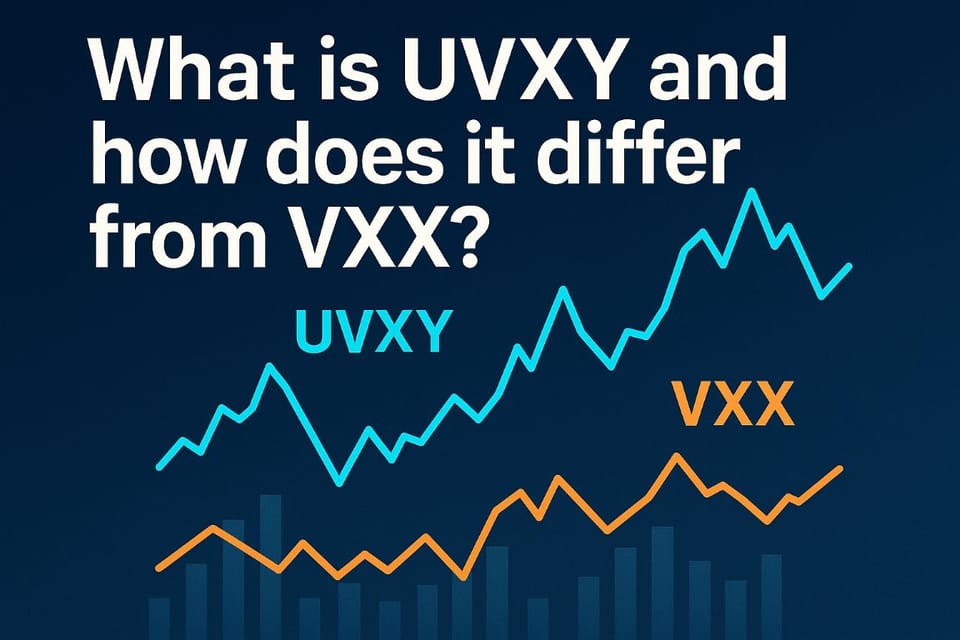What is UVXY and how does it differ from VXX?

Introduction
Individual investors often find volatility products challenging yet intriguing. Many traders wonder: "What is UVXY?" and "Should I trade UVXY or VXX?" These two popular volatility-linked exchange-traded products—UVXY and VXX—attract attention, especially during times of market stress. Understanding the difference between UVXY and VXX is essential for investors seeking exposure to market volatility, as each has unique structures and risks. In this article, we clearly break down UVXY vs VXX, outline their distinctions, and guide investors toward informed decision-making.
Basic Knowledge: UVXY vs VXX
Both UVXY and VXX are popular products linked to VIX futures, but crucially differ in structure and risk profile. UVXY is a leveraged exchange-traded fund (ETF), whereas VXX is an exchange-traded note (ETN).
- UVXY ETF explained: UVXY provides leveraged (1.5x) daily exposure to short-term VIX futures, amplifying volatility movements. Due to daily compounding, its performance often diverges significantly from longer-term VIX movements. Leveraged ETFs like UVXY can generate substantial returns in short-term spikes but carry substantial risks and decay over time due to volatility drag.
- VXX ETN explained: VXX, as an ETN, provides direct exposure to short-term VIX futures without leverage. It tracks the S&P 500 VIX Short-Term Futures Index, aiming to reflect the volatility market closely. Unlike ETFs, ETNs are unsecured debt obligations issued by financial institutions, posing issuer default risk in addition to market risks.
Given these fundamental differences, comparing UVXY leverage vs VXX reveals key distinctions. UVXY's amplified exposure means significantly greater volatility and potential for sharp gains and losses. Conversely, VXX provides relatively lower volatility exposure, better suited for traders seeking less aggressive positions on volatility.
Practical Tips and Key Risks
Historically, investors have made costly mistakes by misunderstanding the unique characteristics of UVXY and VXX. For example, during sudden market downturns such as the COVID-19 crisis in 2020, UVXY surged dramatically due to its leveraged structure, significantly outperforming VXX short-term. However, this was swiftly reversed as markets stabilized, and UVXY saw considerable losses due to volatility decay. Such instances highlight critical lessons for individual investors:
- Volatility Decay: UVXY's daily leverage effect can lead to significant performance deterioration over longer holding periods.
- Issuer Risk: VXX, structured as an ETN, exposes investors to potential credit risks associated with the issuer.
- Short-term Trading Vehicle: Both UVXY and VXX are generally designed for short-term speculative positions rather than long-term investments.
- Market Timing Complexity: Predicting volatility spikes accurately is challenging even for professionals, and incorrect timing can amplify losses, particularly with UVXY.
To avoid common pitfalls, individual investors should:
- Carefully monitor market conditions and volatility indicators.
- Set strict investment timeframes and risk management strategies.
- Clearly understand the difference between UVXY and VXX and choose according to personal risk tolerance.
- Never overlook fundamental risks, including issuer creditworthiness for ETNs and volatility drag for leveraged ETFs.


This comparative price performance chart clearly illustrates the differences in volatility and performance between UVXY and VXX, highlighting the amplified volatility and decay characteristics of UVXY compared to VXX.
Conclusion
When considering UVXY vs VXX volatility ETF options, investors must fully grasp their differing risk profiles and structural distinctions. Understanding these intricacies helps prevent common investor errors and aligns investment choices with individual risk tolerance. Regardless of which product one might prefer, establishing a disciplined market observation routine and consistently prioritizing risk management remain critical practices for navigating volatility markets successfully.